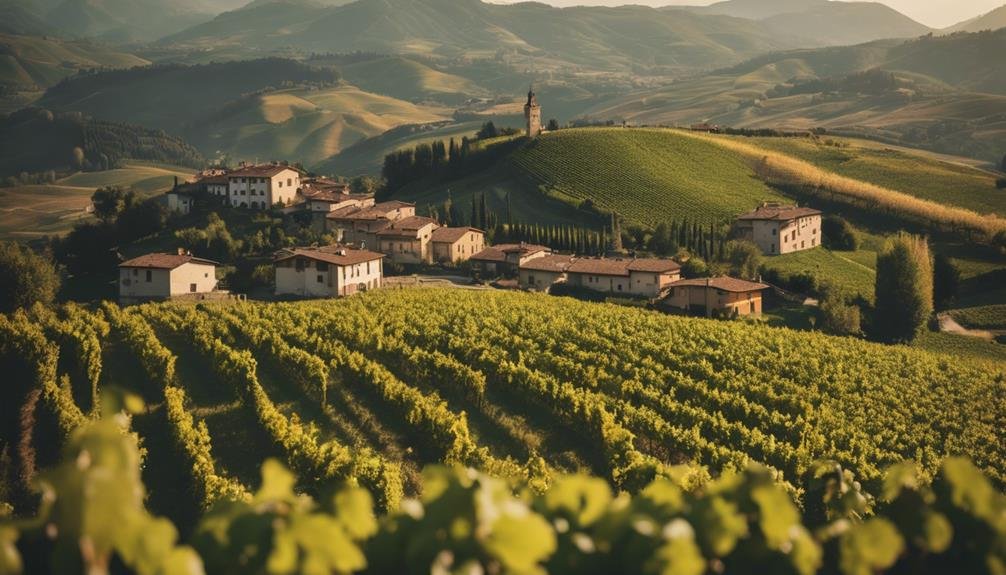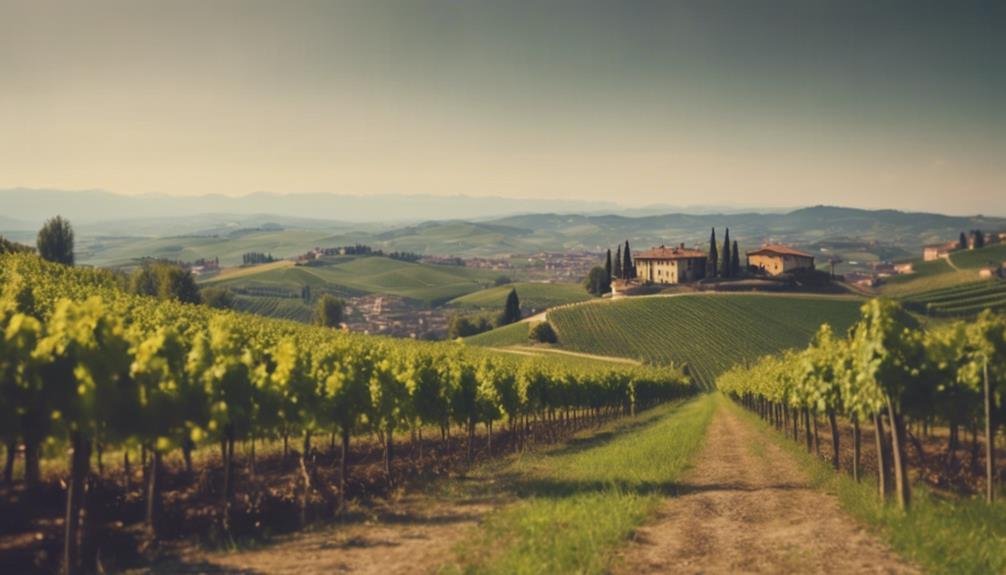Discover an array of Nebbiolo wines beyond Barolo and Barbaresco. Nebbiolo grapes exhibit floral aromas and high tannins with cherry and raspberry notes. Pair with salty or vinaigrette dishes, or get creative with fusion cuisine. Explore diverse Nebbiolo regions like Langhe and Roero for unique flavors. Terroir influences flavor profiles, from delicate in cooler climates to robust in warmer ones. Piedmont's winemaking history spans centuries, with Barolo and Barbaresco as iconic Nebbiolo wines. Uncover a world of Nebbiolo wines waiting to entice wine lovers further.
Nebbiolo Wine Styles and Variability
The Nebbiolo grape showcases a spectrum of wine styles and notable variability, contributing to its allure among oenophiles worldwide. Tasting nuances of Nebbiolo wines often include floral and light red fruit aromas, coupled with a leathery, high tannin structure and cherry and raspberry flavors.
Aromas of rose and anise further enhance its complexity, with variability in taste based on style and vintage. This grape has excellent aging potential, with the ability to develop over decades, refining its flavors and structure.
Nebbiolo wines can be compared to Sangiovese and cool-climate Pinot Noir, offering a unique tasting experience that evolves over time. Understanding these nuances can deepen appreciation for the diverse range of Nebbiolo wines available.
Food Pairing Tips and Suggestions
Enhance your Nebbiolo wine experience by exploring expert food pairing tips and suggestions.
When pairing Nebbiolo wines, consider the flavor profiles to create a harmonious dining experience. Experimentation is key; try matching the wine's leathery, cherry, and raspberry notes with less-gamey meats like roast chicken or pork tenderloin.
The high acidity of Nebbiolo complements saltiness and vinaigrette-based sauces, making it versatile for various cuisines. Fusion cuisine allows for culinary creativity, pairing Nebbiolo not only with traditional Italian dishes but also with Asian flavors.
Balance the wine's tannins with butter, fat, or olive oil to enhance the overall tasting experience. Embrace different meat, cheese, herb/spice, and vegetable pairings to elevate your dining experience with Nebbiolo.
Exploring Nebbiolo Regions Beyond Barolo

Explore the diverse Nebbiolo regions that extend beyond the renowned territories of Barolo and Barbaresco to uncover a spectrum of unique styles and flavors.
In the Langhe region, you'll find a varied investigation of Nebbiolo wines, showcasing the influence of different hills and valleys on the final product.
Moving to Roero, distinct differences emerge with Nebbiolo wines that are more approachable, characterized by reduced tannins compared to their counterparts in Barolo and Barbaresco.
The exploration of these regions offers a fascinating journey through the world of Nebbiolo, highlighting the nuances and complexities that make each area unique.
Investigate Langhe and discover the diversity it offers, while also savoring the differences found in Roero's Nebbiolo offerings.
Nebbiolo Terroir and Climate Influence
Understanding how terroir and climate interact is essential in comprehending the nuanced influence they have on Nebbiolo wine production. Terroir impact, including soil composition, altitude, and sunlight exposure, plays a pivotal role in shaping the flavors and characteristics of Nebbiolo grapes. Different terroirs within regions like Langhe, Barolo, and Barbaresco result in distinct flavor profiles in the final wines.
Climate variations, such as temperature fluctuations and rainfall patterns, further contribute to the grape's development and ultimately the wine's taste. For example, cooler climates can produce Nebbiolo wines with higher acidity and more delicate flavors, while warmer climates may yield richer and more robust wines. By considering these factors, winemakers can harness the unique qualities of Nebbiolo grapes to craft exceptional wines that reflect their terroir and climate influences.
Piedmont Wine History and Significance

Terroir and climate intricately shape the flavors and characteristics of Nebbiolo wines, a process deeply rooted in the historical significance of Piedmont winemaking. The historical origins of winemaking in Piedmont date back centuries, with Nebbiolo being cultivated in the region since at least the 13th century.
This grape variety has had a profound cultural impact, becoming synonymous with the prestigious wines of Barolo and Barbaresco, known for their bold fruit flavors and high tannins. The winemaking traditions in Piedmont have been passed down through generations, shaping the unique styles and characteristics of Nebbiolo wines.
Understanding the history and significance of Piedmont in winemaking provides insight into the rich heritage and craftsmanship behind these exceptional wines.
Frequently Asked Questions
Can Nebbiolo Wines Be Aged for an Extended Period?
Nebbiolo wines can be aged for an extended period, allowing for flavor development. This aging process helps soften the wine's high tannins, enhancing its complexity and allowing for the emergence of secondary aromas and flavors.
What Are Some Unique Characteristics of Roero Nebbiolo?
Roero Nebbiolo stands out with its distinct characteristics. The region's sandy soils impart elegance to the wine, while the microclimate dynamics create a unique balance of acidity and fruitiness. This Nebbiolo offers a refined taste experience.
How Does Elevation Impact Nebbiolo Grape Cultivation?
Elevation in Nebbiolo grape cultivation impacts its quality by influencing microclimates, which regulate temperature and sunlight exposure. This, in turn, affects ripening, tannin development, and flavor complexity. Vineyard management and winemaking techniques must adapt to these varied conditions.
Are There Any Notable Subregions Within Valtellina for Nebbiolo?
Terraced vineyards in Valtellina offer diverse Nebbiolo expressions. Alpine influence shapes the elegant styles of Nebbiolo, reflecting the mountain terroir. Notable subregions like Sassella and Inferno showcase distinct characteristics influenced by Nebbiolo clones, altitude, and microclimates.
What Historical Events Shaped Nebbiolo Production in Piedmont?
Historical events like the Italian wars and the industrial revolution greatly shaped Nebbiolo production in Piedmont. These events influenced vineyard expansion, winemaking techniques, and the rise of Barolo and Barbaresco as renowned Nebbiolo wine regions.
Conclusion
To sum up, Nebbiolo wines offer a wide range of flavors and styles beyond the famous Barolo and Barbaresco appellations. With its diverse expressions and regional distinctions, Nebbiolo showcases the unique terroir and climate influences of Piedmont.
One interesting statistic to note is that Nebbiolo is known as the 'King of Italian Grapes,' highlighting its historical and cultural significance in Italian winemaking.
Explore the complexities of Nebbiolo and savor its intricate flavors with a deeper understanding of this iconic varietal.